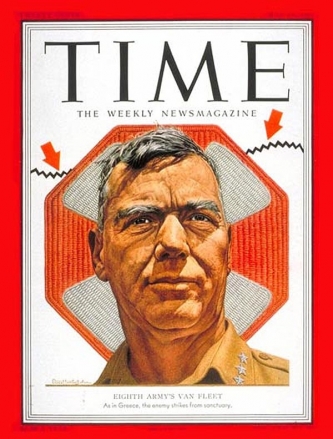The Cold War - The Korean War
 Eight months into the Korean War came this editorial from an American news magazine pointing out that the burden of defending South Korea was not being evenly shared by the other member states of the United Nations and that the U.S. was over-represented on the battlefields:
"When the Korean Communists invaded South Korea last June, the U.N. was quick to authorize the use of armed force to combat the aggression, but not so quick when it came to contributing troops. [As of February, 1951] U.N. forces in Korea total about 275,000. Of this number 150,000 are American and 100,000 are South Koreans. This leaves less than 25,000 from 11 of the other U.N. members - a pitifully small contribution... What is there definition of 'collective security'? Have they so soon forgotten Munich? Have they forgotten that collective firmness by the Allies, when Germany invaded the Rhineland, might have prevented World War II?" Appearing in the June 27, 1951 issue of PATHFINDER was this list of chronological events that made up the first ten months of fighting in the Korean War. The Korean War peace negotiations that took place at Kaesong during August of 1951 are remembered as one of the many failed peace conferences to be convened during the course of that war. The talks were broken off early as a result of a series of U.N. raids that were launched in two different enemy held positions - in addition to an nighttime airstrike that almost decimated the grounds where the talks were being held. The U.N. negotiators were especially frustrated with the fact that the Communists wished that both armies adhere to the 38th Parallel as the post-war border; exactly where the war began. When the Korean War began during the summer of 1950 many Americans were wondering aloud "Is this the beginning of W.W. III?" One year later they were relieved to find that it was not a world war, but the butcher's bill stood at 70,000 U.S. casualties and still there was no end in sight. This article examines these first 365 days of combat, taking into account all losses and gains. There is a set of rocky hills close to the 38th Parallel that came to be known as "Heartbreak Ridge" in the Fall of 1951. It came to pass when a plan was made to secure these hills for the U.N Forces - they thought this would be done in one day - but it continued for a full month. At long last, the 23rd Regiment of the 2nd U.S. Infantry Division finally wrested Heartbreak Ridge from a numerically superior enemy on October 12 - and in so doing, lost half their strength (1,650 men). Attacking across a 125 mile front, the Chinese Army launched their spring offensive on May 17, 1951; unable to make any advances, they retired two weeks later, leaving behind some 80,000 dead. "The Communist hit first on the east central front. A quick rout of two ROK divisions caught the U.S. 2nd Division, commanded by Major General Clark Ruffner, in a dangerous pocket with their east flank exposed...One officer called the Red onslaught 'an astounding demonstration. They wade right through macine gun or artillery fire. The bodies pile up and they walk right over the bodies and the pile of bodies gets higher.'" |
MORE ARTICLES >>> PAGE: * 1 * 2 * 3 * 4 * 5 * 6 * 7 * 8 * 9 * 10 * 11 * > NEXT |
|